| British Rail Class 91 | |||||||||||||||||||||||||||||||||||||||||||||||||||||
|---|---|---|---|---|---|---|---|---|---|---|---|---|---|---|---|---|---|---|---|---|---|---|---|---|---|---|---|---|---|---|---|---|---|---|---|---|---|---|---|---|---|---|---|---|---|---|---|---|---|---|---|---|---|
 LNER Class 91 at London King's Cross LNER Class 91 at London King's Cross | |||||||||||||||||||||||||||||||||||||||||||||||||||||
| |||||||||||||||||||||||||||||||||||||||||||||||||||||
| |||||||||||||||||||||||||||||||||||||||||||||||||||||
| |||||||||||||||||||||||||||||||||||||||||||||||||||||
| |||||||||||||||||||||||||||||||||||||||||||||||||||||
The British Rail Class 91 is a high-speed electric locomotive, which produces power of 4,830 kW (6,480 hp); it was ordered as a component of the East Coast Main Line modernisation and electrification programme of the late 1980s. The Class 91s were given the auxiliary name of InterCity 225 to indicate their envisaged top speed of 225 km/h (140 mph); they were also referred to as Electras by British Rail during their development and throughout the electrification of the East Coast Main Line.
The locomotive body shells are of all-steel construction. Unusually, the motors are body mounted and drive bogie-mounted gearboxes via cardan shafts; this reduces the unsprung mass and hence track wear at high speeds. The locomotive also features an underslung transformer, therefore the body is relatively empty compared to contemporary electric locomotives. Much of the engineering specification for the locomotive was derived from the research and operational experience of the APT-P.
The other end of the InterCity 225 train set is formed of a Mark 4 Driving Van Trailer, built with a similar body shell to the Class 91 locomotives but with only one driving cab.
History
Background
The origins of the Class 91 are closely associated with the East Coast Main Line (ECML) that it has been primarily operated upon. During the 1950s, British Rail had considered electrification of the ECML to be of equal importance to the West Coast Main Line (WCML), but various political factors led to the envisioned electrification programme being delayed for decades; as an alternative, high-speed diesel traction, the Deltic and then the InterCity 125, was introduced upon the route during the 1960s and 1970s. During the 1970s, a working group of British Rail and Department of Transport officials determined that, out of all options for further electrification, the ECML represented the best value by far. Its in-house forecasts determined that increases in revenue and considerable reductions in energy and maintenance costs would occur by electrifying the line.
Accordingly, between 1976 and 1991, the ECML was electrified with 25 kV AC overhead lines. The electrification was installed in two phases: The first phase between London (King's Cross) and Hitchin (including the Hertford Loop Line) was carried out between 1976 and 1978 as the Great Northern Suburban Electrification Project, using Mk. 3A equipment, covering 30 miles (48 km) in total. In 1984, the second phase commenced to electrify the northern section to Edinburgh and Leeds. During the late 1980s, the programme was claimed to be the longest construction site in the world, spanning more than 250 miles (400 km).
In 1989 the InterCity 225 was officially introduced to revenue service. That same year, the ECML had been energised through to York; two years later, electrification had reached Edinburgh, allowing electric services to begin on 8 July 1991, eight weeks later than scheduled. The ECML electrification programme was completed at a cost of £344.4 million (at 1983 prices), a minor overrun against its authorised expenditure of £331.9 million. 40 per cent of the total cost was on new traction and rolling stock and 60 per cent for the electrification of the line.
Options and selection
The electrification of the ECML necessitated the procurement of new high speed electric traction. The options and requirements for this trainset were hotly deliberated for a number of years. On 7 June 1978, the electric-powered prototype Advanced Passenger Train (APT) was unveiled; it was at one point intended for the APT to be the next major intercity express train. However, due to various factors including technical issues, the APT programme was curtailed during the summer of 1983. Shortly thereafter, two alternative options were explored, an electrified version of the InterCity 125 (known as the HST-E), and the Class 89 mixed-traffic locomotive; these were both intended to a peak service speed of 125 mph.
Some officials within British Rail pushed for more demanding requirements for the future Intercity trainset; reportedly, BR's Director of Mechanical and Electrical Engineering (M&EE) was a strong proponent for increasing the top speed to 140 mph. To facilitate this, tilting train technologies developed for the APT were explored. While BR's board had approved the ordering of a single Class 89 as a prototype, the Strategy Committee queried why the type had been favoured over a proposed 80-tonne Bo-Bo locomotive. While the Class 89 was thought to be a low-risk option for multi-purpose traction, it offered little advantage over the existing Class 87 in terms of speed. At the time, the 1950s era Class 81 and Class 85 electric locomotives were nearing the end of their viable service lives and were quite unreliable, but their withdrawal had effectively been ruled out by a national shortage of newer electric traction, in part caused by the APT's cancellation.
A key advantage of the InterCity 225 concept over a Class 89-hauled consist was the lower weight of the former, resulting in less slippage and greater acceleration over the latter. Appraisals also determined that the Class 89 was comparatively inferior in financial terms, in part due to the InterCity 225's prospective compatibility with WCML traction, reducing its development costs. A further cost-saving measure was the decision to base the InterCity 225's technologies on the APT. BR reportedly stated that it had derived 90% of the former's engineering from the latter. Thus, the study group recommended that the InterCity 225 be pursued as the preferred option, while the Class 89 and HST-E initiatives serve as back-ups. Despite this, the HST-E effort was promptly aborted, while Brush Traction decided to de-prioritise work on the Class 89 after learning that it was unlikely to lead to volume production.
By spring 1984, favour was being given towards the adoption of a tilting carriage, tentatively designated as the Mk 4; this was viewed as superior to the existing Mk 3 and enabled a single design to be shared between the ECML and WCML. At one point, it was envisaged that the InterCity 225 would be extremely ubiquitous, even potentially having the capability built into it to operate over the southern third-rail network and within the Channel Tunnel; by mid 1984, such proposals were curtailed. Furthermore, it was decided to reduce the freight haulage capabilities of the InterCity 225, as traction for this sector was instead intended to be served via other platforms. The emergence of the Class 90, derived from the existing Class 87, somewhat reduced the pressure for the InterCity 225, reducing the prospective numbers to be built of the latter. Without tilting carriages, it had little speed advantage over the Class 90 on the WCML.
It was decided to hold a competitive tender for the InterCity 225 programme; this measure was aimed at avoiding the difficulties experienced with the APT programme. A pre-qualification document was formalised, in which various requirements for the type were laid out; these included the need to perform mixed-traffic duties (day and night passenger, parcel and mail, and overnight heavy freight services), the haulage of both tilting and conventional rolling stock, a top speed of 225 km/h, a maximum cant deficiency of 9° without the provision of tilt equipment, and that the maximum unsprung mass could not exceed 1.8 tonnes. Furthermore, BR stated its readiness to sub-contract with the successful bidder for the supply of technical information, advice and testing. The prequalification document was issued to BREL, Brush Traction and the General Electric Company (GEC), as well as the French firm Alsthom and Germany's Krauss Maffei. The inclusion of foreign manufacturers was in part due to the limited domestic experience with trainsets capable of such high top speeds. A total of three companies, ASEA, Brush Traction and GEC, submitted tenders for the design and construction of the Class 91 locomotive.
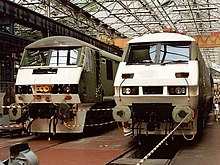
On 14 February 1985, the BR board approved the substitution of the Class 91 for Class 89 for the ECML programme. The tendering process was relatively complex, but a decisive move appeared to have been GEC's offer of a sub-contracting arrangement to BREL for the construction of the locomotive's mechanical elements. It would be GEC's submission that would be selected as the winner; after which a contract for the construction of 31 Class 91 locomotives, along with an option for 25 more for the WCML, was awarded during February 1986. Shortly thereafter, BREL established a production line for the type at its Crewe Works.
Post-introduction developments
The first passenger service to be operated by a Class 91 locomotive was the 17:36 King's Cross to Peterborough on 3 March 1989. From 6 March, members of the fleet began to work services between London and Grantham, and from 11 March services between London and Leeds. With the completion of the East Coast Main Line electrification programme, Class 91 trains reached Newcastle upon Tyne for the first time in service on 10 June 1991, then Edinburgh on 12 June.
In service, as a part of the InterCity 225 sets, the fleet worked alongside Class 90 locomotives and Class 317 electric multiple units. Diesel trains displaced by the Class 91 introduction were reallocated predominantly to the Midland Main Line. The InterCity 225's introduction correlated with a significant increase in passenger numbers using the ECML within two years; one station recorded a 58 per cent increase in passengers.
In the early 1990s, after the cancellation of InterCity 250, British Rail examined the option of ordering a further set of ten Class 91s to operate on the West Coast Main Line with UK Treasury support, however the business case for these failed to prove sufficiently worthwhile. and led to the electric Networker Classes 365, 465 and 466 EMU Networker stock's procurement being taken forward.
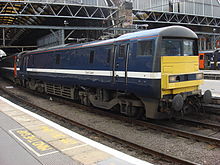

The locomotive body is asymmetric; streamlined at the 'front' (Number 1) end to allow for high-speed operation, but left 'blunt' at the Number 2 end so as to visually blend with the fixed sets of Mark 4 coaches in normal push-pull passenger service. Because of a design requirement that the class be able to function as normal locomotives if so required, a full driver's cab is also provided at the Number 2 end – but the locomotive's maximum speed is reduced to 110 mph (180 km/h) when this cab is at the front of a train.
During the privatisation of British Rail ownership of the Class 91 fleet passed to Eversholt Rail Group, which in turn leased the fleet to its various operators. Eversholt put all 31 locomotives through a £30 million heavy overhaul and refit process (known as Project Delta) between 2000 and 2003, seeking to improve the fleet's reliability. Rail Magazine described it in March 2001 as being necessary because "eight out of ten failures on Class 91s were caused by the sub-standard electrics", and further noted that problems with relays in particular were the "third-biggest" cause of failures. The refit was performed by Adtranz (later Bombardier Transportation), with technical support from Alstom, and involved upgrades to the bogies, electrical systems, air compressors, and parking brakes; alterations to the cab layout at the Number 1 end; the replacement of the original gearboxes with newly designed Voith models; and the installation of TPWS and a new air-cooling system. Overhauled units had their numbers increased by 100; thus 91001 became 91101 and so on – with the exception of 91023, which was renumbered 91132 due to sensitivity around its involvement in both the Hatfield and Selby accidents.
During the overhaul process, GNER hired in Class 90 locomotives to provide cover for their services.
In November 2012, number 91114 had a second pantograph added as a pilot project conducted jointly by Eversholt, East Coast, DB ESG, Wabtec, and Brecknell Willis. The new design uses the same mounting positions as a conventional pantograph but pairs two pantograph arms in an opposing configuration. If there is an ADD (Automatic Dropping Device) activation or the pantograph becomes detached, the train can keep going, so the system provides redundancy in the event of a pantograph/OLE failure.
Speed records
Locomotive 91010 (now 91110) holds the British speed record for electric locomotives, reaching 161.7 mph (260.2 km/h) while on a test run down the East Coast Main Line's Stoke Bank on 17 September 1989. Locomotive 91012 (now 91112) holds the separate record for the fastest non-stop journey between London King's Cross and Edinburgh Waverley; 3 hours 29 minutes on 26 September 1991, running within the 140 mph (230 km/h) speed limit but hauling a shortened set of only five coaches plus DVT. The time converts to an average speed of 112.5 mph (181.1 km/h).
Despite these successes, however, Class 91 locomotives have never used their 140 mph top speed in regular service, because testing conducted by British Rail in 1988 established that drivers could not interpret and act upon line-side signal aspects with sufficient consistency and accuracy when driving at speeds exceeding 125 mph (201 km/h). Regulations throughout Britain were subsequently amended to require the use of in-cab signalling whenever running service trains at speeds above 125 mph, an option that BR were unwilling to pursue at the time.
Fleet
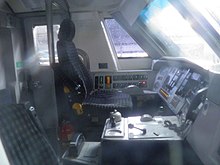
When British Rail was privatised, the InterCity livery was progressively removed and new operator GNER applied their corporate livery of blue and red. When GNER lost their franchise in 2007, the red stripe was replaced by a white stripe containing the words National Express and East Coast. National Express East Coast originally planned to repaint all of their InterCity 225 sets in the white and silver NXEC corporate livery within two years. However, the collapse of NXEC in 2009 and its replacement with East Coast saw this repainting programme cancelled. As a result, 91111 was the only locomotive to receive the full National Express livery.
In June 2010, a new silver livery with a purple stripe was unveiled by East Coast. By February 2011, locomotives 91101, 91106, 91107 and 91109 carried this livery. Locomotive 91101 was soon given maroon vinyls, with Flying Scotsman branding. Locomotive 91107 was given promotional "Skyfall" vinyls for a time during 2012–3. The locomotive later returned to conventional Virgin Trains East Coast livery. Locomotive 91110 carries 'BBMF' Battle Of Britain Memorial Flight livery. By 2013, all locomotives carried the standard East Coast livery of silver/grey with a purple stripe. 91118 was the last locomotive to carry GNER/NXEC livery. All Mark 4 coaches and DVTs have since been repainted. On 14 October 2014, at Newcastle station, locomotive 91111 was unveiled in a commemorative World War I livery and named 'For The Fallen'.
The Class 91 fleet has carried nameplates applied in various batches and themes. Immediately after repainting into GNER colours in the late 1990s, all locomotives were briefly nameless. Having initially been applied to only a few locomotives in the early 1990s using cast-iron plates, eventually the whole fleet was named, many multiple times, until all were removed in 2008. In 2011, in response to customer requests, East Coast resumed the practice. It began by naming No. 91109 as Sir Bobby Robson with cast-iron plates, unveiled in a ceremony at Newcastle station on 29 March by his widow Elsie and Alan Shearer.
List of Class 91 locomotives
| Key: | In service | Stored | Scrapped | Preserved | Exported |
|---|
| Current Number | Previous Number | Current name | Previous name(s) | Current livery | Built | Operator | Status | Notes |
|---|---|---|---|---|---|---|---|---|
Class 91/1 |
Class 91/0 | |||||||
| 91101 | 91001 | Flying Scotsman | LNER InterCity | April 1988 | LNER | Operational | ||
| 91102 | 91002 | City of York | Durham Cathedral | April 1988 | Scrapped | Scrapped at Sims, Newport, May 2021. | ||
| 91103 | 91003 | April 1988 | Scrapped | Arrived at C F Booth, Rotherham for scrapping, March 2022. Scrapped in August 2022. | ||||
| 91104 | 91004 | June 1988 | Scrapped | Arrived at C F Booth, Rotherham for scrapping, March 2022. | ||||
| 91000 | 91005
91105 |
LNER InterCity | May 1988 | LNER | Operational | Renumbered January 2024 to celebrate 1000th issue of Rail magazine | ||
| 91106 | 91006 | East Lothian | LNER InterCity | June 1988 | LNER | Operational | ||
| 91107 | 91007 | Skyfall | LNER InterCity | July 1988 | LNER | Operational | Was temporarily renumbered back to 91007 for the duration of the Skyfall promotion. | |
| 91108 | 91008 |
|
July 1988 | Scrapped | Went off lease in July 2019; first Class 91 locomotive to be withdrawn. Scrapped at C F Booth, Rotherham, May 2022. | |||
| 91109 | 91009 | Sir Bobby Robson | LNER InterCity | August 1988 | LNER | Operational | ||
| 91110 | 91010 | Battle of Britain Memorial Flight | Battle of Britain Memorial Flight artwork | April 1989 | LNER | Operational | The locomotive holds the national speed record for electric locomotives of 162 mph attained at Stoke Bank near Peterborough on 17 September 1989. Selected for preservation in the National Collection. | |
| 91111 | 91011 | For the Fallen | Terence Cuneo | For the Fallen artwork | February 1990 | LNER | Operational | World War I commemoration. |
| 91112 | 91012 | County of Cambridgeshire | April 1990 | Scrapped | Hauled to Sims, Newport, on 3 February 2023 | |||
| 91113 | 91013 | April 1990 | Scrapped | Scrapped at Sims, Newport, May 2021. | ||||
| 91114 | 91014 | Durham Cathedral | LNER InterCity | May 1990 | LNER | Operational | Previously fitted with experimental two-in-one pantograph. | |
| 91115 | 91015 | Blaydon Races | Holyrood | May 1990 | Scrapped | Hauled to Sims, Newport, on 3 February 2023 | ||
| 91116 | 91016 | Strathclyde | LNER red/white | June 1990 | LNER | Stored | Currently in warm storage at Belmont Yard, Doncaster. | |
| 91117 | 91017 | Europhoenix | July 1990 | Europhoenix | Stored | Went off-lease on 25 September 2019. Currently stored at Barrow Hill. To be used as a spares donor in the project to reactivate 89001 Avocet. | ||
| 91118 | 91018 | The Fusiliers | LNER red/white | August 1990 | LNER | Stored | Currently in warm storage at Belmont Yard, Doncaster. | |
| 91119 | 91019 | Bounds Green Intercity Depot | BR InterCity 'Swallow' | August 1990 | LNER | Operational | ||
| 91120 | 91020 | Royal Armouries | BR Intercity 'Swallow' | October 1990 | Europhoenix | Stored | On display at Crewe Heritage Centre on long-term loan from Europhoenix. | |
| 91121 | 91021 | LNER red/white | October 1990 | LNER | Stored | Formerly carried pride decorations and was known as the "Trainbow". Currently in warm storage at Belmont Yard, Doncaster. | ||
| 91122 | 91022 | October 1990 | Scrapped | Used following withdrawal in testing of overhead wires on the Midland Main Line, scrapped in October 2022. | ||||
| 91124 | 91024 | Reverend W Awdry | LNER InterCity | September 1990 | LNER | Operational | ||
| 91125 | 91025 | October 1990 | Scrapped | Previously carried promotional livery for Sky 1 HD. Hauled to Sims, Newport, on 3 February 2023. | ||||
| 91126 | 91026 | Darlington Hippodrome |
|
March 1991 | Scrapped | Scrapped at Sims, Newport, May 2021. | ||
| 91127 | 91027 | Neville Hill | LNER InterCity | December 1990 | LNER | Operational | First locomotive in LNER InterCity livery. | |
| 91128 | 91028 | InterCity 50 | January 1991 | Scrapped | Used following withdrawal in testing of overhead wires on the Midland Main Line, scrapped in July 2022. | |||
| 91129 | 91029 | Queen Elizabeth II | January 1991 | Scrapped | Scrapped at Sims, Newport, May 2021. | |||
| 91130 | 91030 | Lord Mayor of Newcastle | LNER InterCity | March 1991 | LNER | Operational | ||
| 91131 | 91031 | LNER red/white | March 1991 | Preserved | Last locomotive built at Crewe Works. Preserved at the Museum of Scottish Railways. | |||
| 91132 | 91023 | City of Durham | September 1990 | Scrapped | Involved in both Hatfield and Great Heck accidents. Renumbered 91132 (rather than 91123) after 2001 refurbishment. Scrapped at Sims, Beeston, March 2021. |
| Year | Quantity in service at start of year |
Quantity withdrawn |
Locomotives withdrawn |
|---|---|---|---|
| 2019 | 31 | 4 | 91103, 91108, 91117, 91120 |
| 2020 | 27 | 15 | 91102, 91104, 91112–91113, 91115–91116, 91118, 91121–91122, 91125–91126, 91128–91129, 91131–91132 |
Operators
| Operator | Years | Livery | Image |
|---|---|---|---|
| InterCity | 1988–1996 | Intercity Swallow (red, white, and black) | 
|
| Great North Eastern Railway | 1996–2007 | Navy blue with red detailing | 
|
| National Express East Coast | 2007–2009 | Interim livery (navy blue with white stripe) | 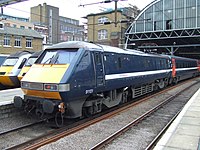
|
| 2007–2009 | National Express corporate grey (only used on 91111) | 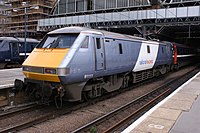
| |
| East Coast | 2009–2015 | East Coast silver with purple stripe | 
|
| Virgin Trains East Coast | 2015–2018 | Virgin Trains corporate red and white | 
|
| London North Eastern Railway | 2018–2023 | LNER red and white (VTEC red/white with LNER branding) | 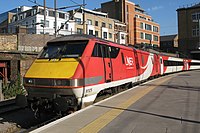
|
| 2022–present | LNER InterCity 225 (red, white, and oxblood) | 
| |
| Europhoenix | 2019–present | Europhoenix grey, silver, and red (with a phoenix motif branding) | 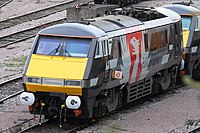
|
Current operations
The fleet, which was previously operated by InterCity and then GNER, National Express East Coast, East Coast and Virgin Trains East Coast, is currently run by London North Eastern Railway.
In July 2019, 91108 was the first of the class to be withdrawn. Following the withdrawal of the InterCity 125 fleet in December 2019, it was previously thought that the InterCity 225 fleet would be fully withdrawn by June 2020. However, LNER announced on 29 January 2020 that they would be retaining a limited number of the InterCity 225 fleet to deliver all of the benefits of their December 2021 timetable. LNER later confirmed that they would be keeping 10 sets in service.
In September 2020, Eversholt Rail Group and London North Eastern Railway extended their lease to ten by 2023. In addition, there are options to make it operational until 2024. It will be overhauled at the Wabtec Doncaster plant.
At the end of service on 15 January 2021, the remaining serviceable InterCity 225 sets went into storage temporarily as part of the East Coast Upgrade. Originally, the plan was to return the sets to service for 7 June 2021, but instead the first set re-entered service on 11 May 2021 due to a number of Azuma sets having to be taken out of service.
Future operations
Europhoenix purchased 91117 and 91120 in September 2019. They were repainted at Bounds Green TMD before moving to UK Rail Leasing's Leicester depot. They are to be re-geared for freight operation in Europe. In September 2022, 91120 moved to Crewe Heritage Centre on long-term loan from Europhoenix.
Rail Operations Group have taken a pair of Class 91s for use in testing of the newly electrified Midland Main Line prior to the introduction of regular electric services between Bedford and Corby. The company has also expressed interest in using the Class 91s on high speed logistics trains.
Grand Union is proposing to operate InterCity 225s on London Paddington to Cardiff Central and London Euston to Stirling services.
Scrapping
91132 was the first Class 91 to be scrapped, at Sims Metals scrapyard in Nottingham in 2021.
Preservation
91131 was nominated by the Railway Heritage Committee to be preserved upon its retirement; in March 2023, it moved to preservation at the Museum of Scottish Railways at the Bo'ness and Kinneil Railway.
In June 2021, the 225 Group was launched; their intention is to preserve a further Class 91 and an InterCity 225 set.
In September 2022, Crewe Heritage Centre received 91120 on long-term loan from Europhoenix.
Notes
- The rheostatic brake is the primary locomotive and train brake and is used at speeds down to approximately 30 mph (48 km/h). Below this speed it is blended with the conventional pneumatic brakes.
- Imposed to ensure that the locomotive can be adequately braked by the friction brakes alone in the event that the rheostatic brake fails.
- Maximum rheostatic brakeforce is available between speeds of approximately 60 to 125 mph (97 to 201 km/h). Below 60 mph the maximum effort available decreases linearly to zero, and above 125 mph it is limited to 50 kN (11,000 lbf).
References
- ^ Fawcett, M. (April 2008). Vehicle Diagram Book - Class 91 Locomotive (1 ed.). London: HSBC Rail UK. EV/DB0910. Archived from the original on 6 May 2021. Retrieved 6 May 2021.
- ^ Kaller, Roger; Allenbach, Jean-Marc (1995). Traction électrique (PDF) (in French). Lausanne: Presses polytechniques et universitaires romandes. p. 8.2.91. Archived (PDF) from the original on 14 May 2021. Retrieved 25 April 2012.
- ^ Railway Industry Association (1988). "Elektrische Lokomotive Klasse 91 - Technische Daten / Class 91 Electric Locomotive - Technical Information" (JPEG). Grossbritanniens Neue Eisenbahnen / Britain's New Railways (in German and English). London: British Railways Board. Archived from the original on 19 November 2022.
- ^ System Data for Mechanical and Electrical Coupling of Rail Vehicles in support of GM/RT2190 (PDF). London: Rail Safety and Standards Board. 22 June 2011. SD001. Archived from the original (PDF) on 1 April 2012. Retrieved 22 November 2022.
- ^ Donnison, P.J.; West, G.R. (September 1989). "The design and development of the Class 91 locomotive". International Conference on Main Line Railway Electrification 1989: 294–298.
- Clinnick, Richard (10 October 2019). "Europhoenix earmarks '91s' for European freight use". Rail Magazine. Peterborough: Bauer Consumer Media. Archived from the original on 12 October 2019. Retrieved 12 October 2019.
- ^ Bendall, Simon; Coward, Andy (April 2023). "More Class 91s head for scrap". Railways Illustrated. No. 242. Horncastle: Mortons Media Group. p. 18.
- ^ Stanton, Peter (23 November 2017). "ECML Power Supply Upgrade". Rail Engineer. Derby: RailStaff Publications. Retrieved 19 November 2022.
- ^ Shirres, David. "ECML: Electrification as it used to be". Rail Engineer. Coalville: Rail Media Group. Archived from the original on 11 January 2018. Retrieved 10 January 2018.
- Your New Electric Railway: The Great Northern Suburban Electrification (PDF). British Rail. 1973. BR(E) M68 (4/73). Archived (PDF) from the original on 24 September 2015. Retrieved 18 March 2014.
- Semmens, Peter (March 1991). Electrifying the East Coast Route: Making of Britain's First 140 m.p.h. Railway. Wellingborough: Patrick Stephens. ISBN 978-0-85059-929-9.
- "Back to the future as history made with East Coast rail icons". York: National Railway Museum. 24 April 2017. Archived from the original on 11 January 2018. Retrieved 10 January 2018.
- "First impressions of ATP-P". Modern Railways. Vol. 35, no. 359. Ian Allan. August 1978. pp. 354–358. ISSN 0026-8356.
- ^ "Class 91s... promise unfulfilled". Rail Magazine. No. 869 (January 2019). Peterborough: Bauer Consumer Media. Archived from the original on 29 July 2019. Retrieved 9 December 2020.
- Ford, Roger (April 1988). "Managing Electra". Modern Railways. ISSN 0026-8356.
- ^ Clinnick, Richard (20 March 2013). "No rest for the '91s'". Rail Magazine. Peterborough: Bauer Consumer Media. Retrieved 19 November 2022.
- Vincent, Mike (2013). InterCity Story 1964-2012. Oxford Publishing Company. ISBN 978-0860936527.
- Pritchard, Robert; Fox, Peter; Hall, Peter (April 2007). British Railways Locomotives & Coaching Stock 2007. Sheffield: Platform 5 Publishing. ISBN 978-1-902336-55-8.
- "Second pantograph fitted to '91' in bid to cut failures". Rail Magazine. Peterborough: Bauer Consumer Media. 28 November 2012. p. 6.
- "Duplex pantograph prototype unveiled". Railway Strategies. No. 475. Norwich: Schofield Publishing. 1 February 2013. Archived from the original on 12 November 2013. Retrieved 12 November 2013.
- "Class 91 hits 162 mph". Rail Magazine. No. 106. EMAP National Publications. 5–18 October 1989. p. 5. ISSN 0953-4563. OCLC 49953699.
- "RPS listing of 'special' runs" (PDF). Railway Performance Society. June 2006. Retrieved 21 February 2023.
- ^ Bickell, David (15 November 2018). "The digital railway – progresses to the East Coast Main Line". Rail Engineer. Coalville: Rail Media Group. Retrieved 4 February 2023.
- Heath, D. L.; Wood, A. M. J.; Fenwick, T. H.; Riddell, J. B. (August 1994). "Discussion: Electrification of British Railway's East Coast Main Line". Proceedings of the Institution of Civil Engineers - Transport. 105 (3): 232. doi:10.1680/itran.1994.26798.
- Cover, Ron (9 August 2010). Tuplin, Richard (ed.). "East Coast goes silver and purple!" (PDF). Railway Herald (223): 3. ISSN 1751-8091. Archived from the original (PDF) on 15 July 2011. Retrieved 12 August 2010.
- "91101 at Leeds". 5 October 2010. Archived from the original on 27 September 2011.
- "East Coast unveils tribute "For the Fallen"" (Press release). East Coast. 14 October 2014. Archived from the original on 19 December 2014. Retrieved 5 January 2015.
- "Sir Bobby Robson name given to train". BBC News. 29 March 2011. Archived from the original on 25 December 2017. Retrieved 29 March 2011.
- "East Coast Names Train Sir Bobby Robson" (Press release). East Coast. 29 March 2011. Archived from the original on 27 May 2011. Retrieved 29 March 2011.
- "First Minister launches new Virgin Flying Scotsman train" (Press release). Virgin Trains East Coast. 28 October 2015. Archived from the original on 6 January 2021. Retrieved 6 November 2015.
- "Reg's return heralds unveiling of iconic train name" (Press release). East Coast. 1 December 2011. Retrieved 8 March 2012.
- ^ "Four more Class 91s dispatched for scrap to Newport". The Railway Magazine. June 2021. p. 102.
- ^ Butlin, Ashley (April 2022). "Stock Update". The Railway Magazine. No. 1453. p. 81.
- ^ "Class 91 disposals continue". Railways Illustrated. No. 237. November 2022. p. 13.
- "Meet 91000: 'our' Class 91 will be operating on the East Coast Mainline". Rail. No. 1000. 10 January 2024. p. 6.
- ^ "LNER operational Class 91 liveries". Railways Illustrated. No. 239. January 2023. p. 19.
- ^ "Now arriving at Platform 007". East Coast (Press release). Archived from the original on 20 June 2014. Retrieved 31 May 2013.
- @LNER (21 July 2019). ""On Monday 22nd July after thirty years of service, we bid a final farewell to locomotive 91108."" (Tweet). Archived from the original on 6 January 2021. Retrieved 22 July 2019 – via Twitter.
- Newton, Grace (22 July 2019). "Watch: Train driver's poignant horn blast as retiring LNER locomotive leaves York for the final time". The Yorkshire Post. Archived from the original on 6 January 2021. Retrieved 23 July 2019.
- "East Coast names train "Sir Bobby Robson"" (Press release). East Coast. 29 March 2011. Archived from the original on 27 May 2011. Retrieved 8 March 2012.
- "Lot 328, GCR Auction, Sale 122". GCR Auctions. Archived from the original on 30 November 2011. Retrieved 3 April 2012.
- ^ Holden, Michael (10 November 2022). "LNER's InterCity Swallow liveried Class 91 locomotive is latest to be repainted". RailAdvent. Retrieved 3 March 2023.
- "East Coast unveils moving tribute "For The Fallen"". East Coast (Press release). 14 October 2014. Archived from the original on 19 December 2014.
- "East Coast train named "Durham Cathedral"". East Coast (Press release). 3 July 2013. Archived from the original on 14 July 2013.
- "Famous North East anthem 'Blaydon Races' takes to the tracks" (Press release). East Coast. 6 June 2012. Archived from the original on 24 December 2012. Retrieved 6 June 2012.
- "West Riding region honoured at train naming ceremony" (Press release). East Coast. 13 September 2012. Archived from the original on 9 March 2012. Retrieved 8 March 2012.
- @LNER (25 September 2019). "Today, we say goodbye to 91117 (West Riding Limited)" (Tweet). Archived from the original on 6 January 2021. Retrieved 25 September 2019 – via Twitter.
- "Virgin Trains reveal 'The Fusiliers' train". RailAdvent. 28 March 2018. Archived from the original on 6 January 2021. Retrieved 5 April 2018.
- "Bounds Green depot celebrates 40 years of HST maintenance by naming a Class 91!". Steven Knight Media. 14 October 2017. Archived from the original on 6 January 2021. Retrieved 14 October 2017.
- "Back in time for europhoenix 91120". Railways Illustrated Magazine. Readly. 3 October 2023. Retrieved 15 October 2024.
- ^ "91 120 Loaned To Crewe Heritage Centre". The Crewe Heritage Centre. 29 September 2022. Retrieved 13 October 2022.
- "LNER Celebrates Summer of Pride on East Coast Route". London North Eastern Railway. 26 August 2019. Archived from the original on 26 May 2022. Retrieved 6 September 2022.
- "Radio Rewind - BBC Radio 1 Timeline - 1978 to 1992". www.radiorewind.co.uk. Archived from the original on 6 January 2021. Retrieved 30 March 2012.
- "Virgin Loco 91 126 Named Darlington Hippodrome". Railway Adventures. 21 November 2017. Archived from the original on 6 January 2021. Retrieved 26 November 2017.
- "Neville Hill name for Class 91". Rail Express. No. 329. Horncastle: Mortons Media Group. October 2023. p. 12.
- ^ "New Livery for LNER InterCity 225 Fleet as Part of Essential Maintenance". London North Eastern Railway. 13 June 2022. Archived from the original on 17 July 2022. Retrieved 6 September 2022.
- @richardsalkeld (7 July 2016). "Intercity 50" (Tweet). Archived from the original on 6 January 2021. Retrieved 7 December 2016 – via Twitter.
- "All aboard the Lord Mayor of Newcastle as train celebrates city anniversary". The Northern Echo. 7 December 2016. Archived from the original on 6 January 2021.
- ^ Bo'ness & Kinneil Railway (10 March 2023). "Class 91131 has arrived safely at B&KR. You can see the loco in our @Mus_Scot_Rways from April 2023" (Tweet). Retrieved 3 April 2023 – via Twitter.
- ^ "First LNER Class 91 locomotive set to be scrapped in Nottingham". RailAdvent. 19 March 2021. Archived from the original on 22 March 2021. Retrieved 6 April 2021.
- "First Class 91 withdrawn from traffic by LNER". Rail. No. 884. 31 July 2019. p. 28.
- "FROM THE ARCHIVES: Traction transition: HST to Azuma". www.railmagazine.com. Archived from the original on 21 January 2020. Retrieved 17 January 2020.
- @LNER (29 January 2020). "If you're a fan of our IC225 trains, you can continue to enjoy them for a bit longer. We are retaining a number of them in order to deliver all of the benefits of our Dec 2021 timetable plans" (Tweet). Archived from the original on 30 January 2020. Retrieved 30 January 2020 – via Twitter.
- @LNER (5 February 2020). "18 currently and we are keeping 10 till the end of 2021" (Tweet). Archived from the original on 6 February 2020. Retrieved 5 February 2020 – via Twitter.
- "IC225 Fleet Lease Extension and Overhaul". eversholtrail.co.uk. 10 September 2020. Archived from the original on 24 November 2020. Retrieved 25 December 2020.
- Holden, Michael (10 September 2020). "LNER to retain 10 Class 91s up to 2023, as overhaul contracts awarded". RailAdvent. Archived from the original on 27 February 2021. Retrieved 25 December 2020.
- @DavidHorne (15 January 2021). "Last day in service for our speed record-breaking #Class91 locomotives today... for a while" (Tweet). Archived from the original on 15 January 2021 – via Twitter.
- "LNER reintroduces stored InterCity 225 trains into service". Rail Technology Magazine. Archived from the original on 12 May 2021. Retrieved 12 May 2021.
- Clinnick, Richard (10 October 2019). "Europhoenix earmarks '91s' for European freight use". www.railmagazine.com. Archived from the original on 12 October 2019.
- Clinnick, Richard (5 February 2020). "ROG to use Class 91s for Midland Main Line electrification testing". Rail Magazine. Bauer Media. Archived from the original on 26 July 2020. Retrieved 27 July 2020.
- Clinnick, Richard (24 April 2019). "May start for withdrawal of LNER's redundant trains". Rail Magazine. No. 877. Peterborough: Bauer Media. p. 32. ISSN 0953-4563.
- "Cardiff – London open access plan". Railway Gazette International. 19 June 2019. Archived from the original on 22 June 2019.
- "Grand Union Trains notification form on an open access service that may be subject to the Economic Equilibrium Test | Office of Rail and Road". www.orr.gov.uk. 27 August 2019. Archived (PDF) from the original on 28 August 2019.
- "Class 60 to be saved for preservation". Rail. No. 678. 7 September 2011. p. 33.
- "Crewe's record-breaking '91' saved for Bo'ness museum". Rail Magazine. Peterborough: Bauer Consumer Media. 6 January 2023. Retrieved 6 January 2023.
- Denton-Cardew, Benjamin. "The 225 Group". The 225 Group. In house. Retrieved 18 October 2022.
Literature
- P.J. Donnison; G.R. West (25–28 September 1989), Institution of Electrical Engineers (ed.), "The design and development of the class 91 locomotive", IEE Conference Publication (312): 294–298, ISBN 978-0-85296-384-5
- P.C. Bennett (25–28 September 1989), Institution of Electrical Engineers (ed.), "Aspects of the design, construction and testing of BRB's Class 90 and 91 locomotive transformers", IEE Conference Publication (312): 279–283, ISBN 978-0-85296-384-5
- R. Dettmer (12 May 1998), "The Class 91 locomotive. Learning from the APT", IEE Review, 34 (5): 188–189, doi:10.1049/ir:19880072 (inactive 7 December 2024), ISSN 0953-5683
{{citation}}: CS1 maint: DOI inactive as of December 2024 (link) - Broom, M. L.; Smart, G. W. (1990). "The design, manufacture and assembly of the wheelset for the British Rail Class 91, 25 kV, 225 km/h locomotive". Proceedings of the Institution of Mechanical Engineers, Part F: Journal of Rail and Rapid Transit. 204 (26): 141. doi:10.1243/PIME_PROC_1990_204_200_02. S2CID 111232510.
Further reading
- Clinnick, Richard (28 November – 11 December 2012). "Second pantograph fitted to '91' in bid to cut failures". RAIL. No. 710. Peterborough: Bauer. p. 6. ISSN 0953-4563. OCLC 49953699.
External links
- Coxon, Dave. "IC225 and Class 91 commissioning". Testing Times. Archived from the original on 22 April 2022.
- Fabricius, Paul (director) (1988). Running to Time (Television production). Equinoxe. London: Channel Four Television Company.
| British railway locomotives and miscellany, 1948 to present | |
|---|---|
| Diesel shunters | |
| Diesel shunters (pre-TOPS) | |
| Main-line diesels: | |
| Main-line diesels (pre-TOPS) | |
| Electrics | |
| Electrics (pre-TOPS) | |
| Multi-modes | |
| Departmental | |
| Prototypes | |
| Getlink locomotives | |
| Steam locomotives | |
| Ships | |
| General Electric Company | |||||
|---|---|---|---|---|---|
| Former subsidiaries and divisions | |||||
| Former joint ventures | |||||
| Predecessors and acquisitions | |||||
| Successors | |||||
| Products |
| ||||
| People | |||||
| Other | |||||